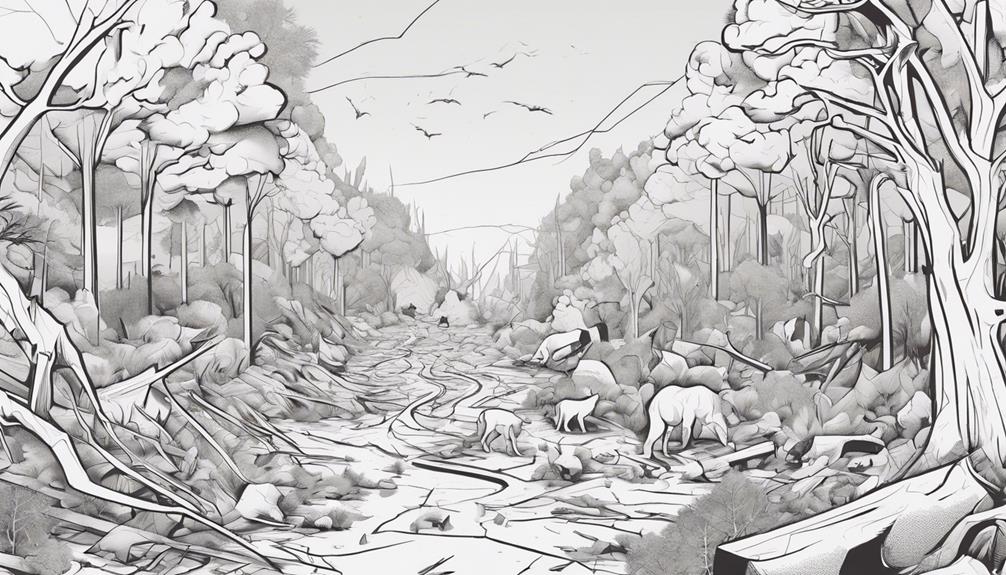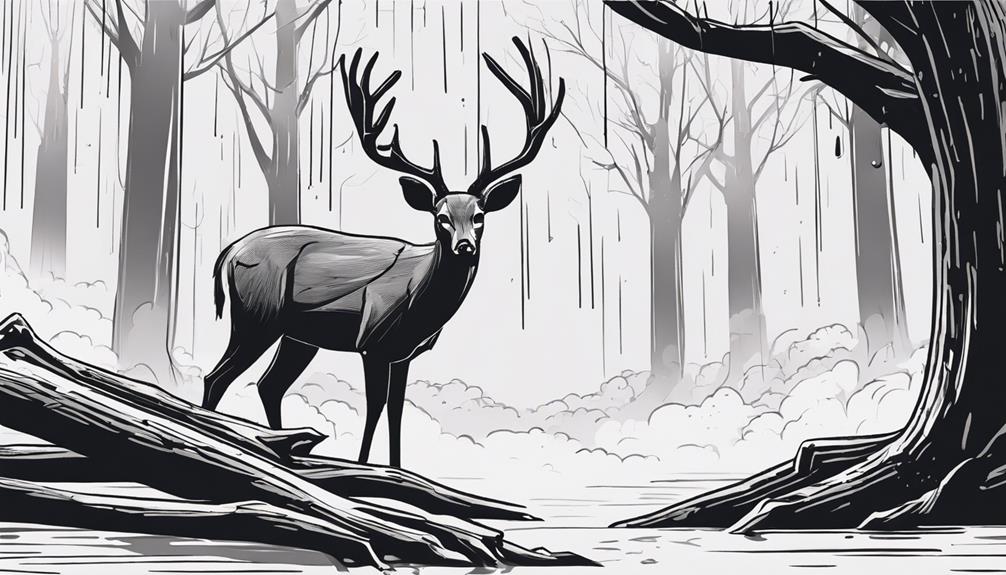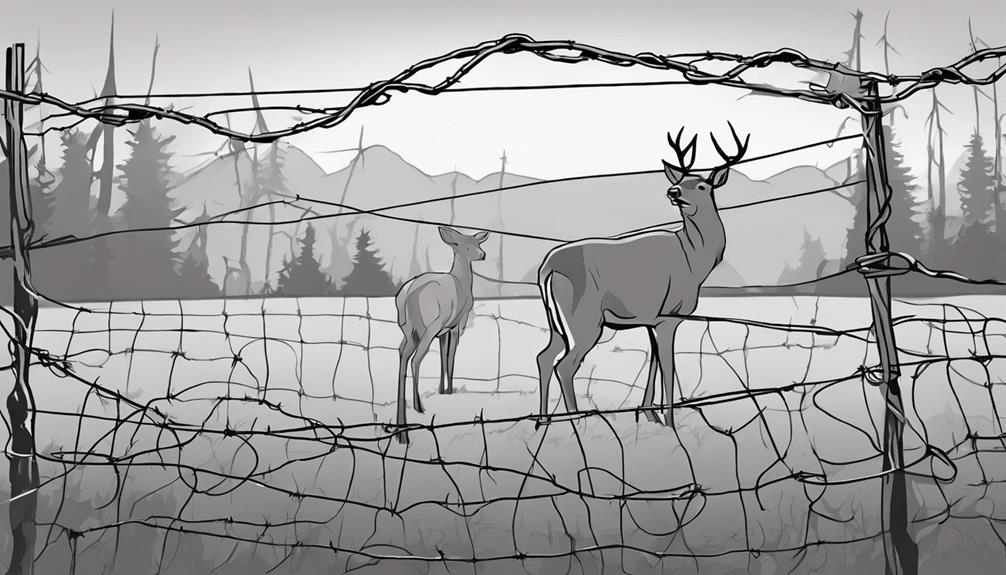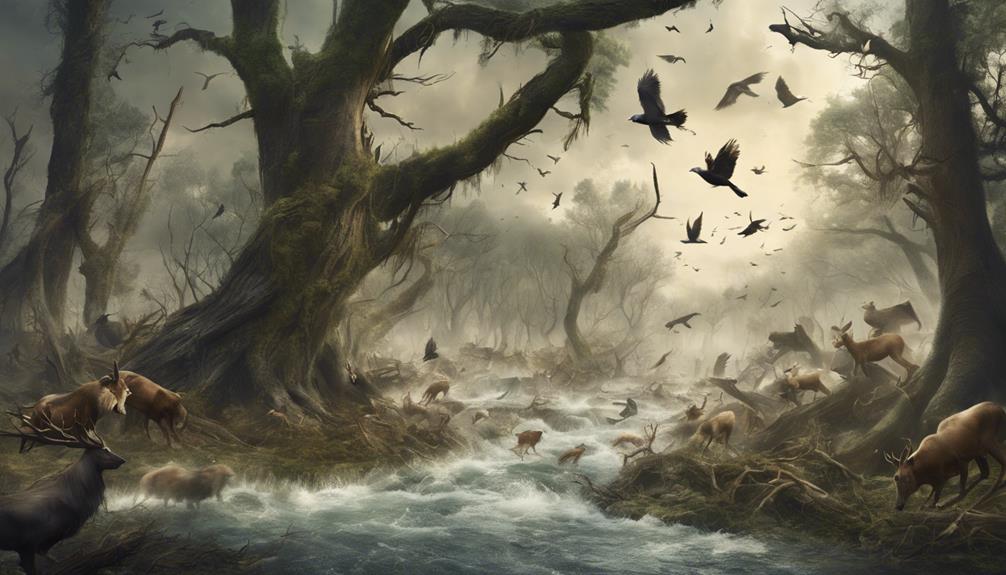Natural disasters are a force of nature that not only impact human lives but also have profound consequences for wildlife. The intricate web of ecosystems faces a myriad of challenges during these events, from immediate threats like physical harm and loss of habitat to the enduring struggle for survival in the aftermath. Understanding how various species cope with and adapt to such upheavals provides invaluable insights into the resilience and vulnerability of wildlife in the face of nature's fury. The intricate dance between disaster and wildlife unveils a complex narrative that merits exploration to grasp the full extent of the impact on our natural world.
Key Takeaways
- Wildlife face displacement, injuries, and habitat loss during earthquakes, wildfires, storms, eruptions, and human conflicts.
- Species evolve to survive disasters like fires, storms, and volcanic eruptions through adaptive behaviors.
- Conservation efforts post-disaster focus on habitat restoration, wildlife recovery, and protection laws for vulnerable species.
- Natural disasters impact wildlife populations through killed animals, habitat destruction, disrupted migration, and scarcity of resources.
Impact of Earthquakes on Wildlife

The impact of earthquakes on wildlife is a critical aspect of understanding the ecological repercussions of seismic events. Earthquakes, known to trigger tsunamis and landslides, pose significant threats to animals. In human-populated areas, animals may find themselves buried under rubble from collapsed buildings, leading to injuries and fatalities. However, the effects of earthquakes are not limited to land-dwelling creatures; marine animals also face challenges. Whales, which heavily rely on underwater sound for communication, prey detection, and navigation, are particularly vulnerable during seismic events. The disturbance caused by earthquakes can result in hearing damage and displacement of these magnificent marine mammals. The tragic outcomes of earthquakes have been observed in the form of killed and displaced animals, underscoring the susceptibility of wildlife to the destructive forces unleashed by such geophysical occurrences. Understanding these dynamics is crucial for devising strategies to mitigate the impact of earthquakes on diverse animal populations.
Wildlife Response to Wildfires
In response to the destructive forces of wildfires, wildlife exhibits a range of adaptive behaviors aimed at survival and recovery. During wildfires, animals may seek refuge in burrows, bodies of water, or under rocks to escape the flames and smoke. However, smoke inhalation and burns can severely impact wildlife populations, leading to both immediate and long-term consequences. Habitat destruction caused by wildfires results in food scarcity and loss of shelter, further challenging wildlife survival.
| Wildlife Response to Wildfires |
|---|
| Seeking refuge in burrows, bodies of water, or under rocks |
| Impact of smoke inhalation and burns on wildlife populations |
| Habitat destruction leading to food scarcity and shelter loss |
| Evolution of fire-adapted behaviors in some wildlife species |
| Focus on post-wildfire recovery efforts to restore habitats |
Efforts post-wildfire focus on restoring habitats and providing resources to aid in the recovery of affected wildlife populations. Wildlife survival behaviors and the ability of certain species to adapt to fire play crucial roles in maintaining biodiversity and ecosystem resilience in the face of wildfires.
Wildlife Survival in Storms

Wildlife faces significant challenges in navigating and surviving the destructive forces of storms, including strong winds, heavy rains, and flooding. Storms, such as hurricanes, can severely affect animals by disrupting their habitats and food sources. Animals like birds, mammals, and marine life may struggle to find shelter and move through the chaos caused by these natural disasters. Climate change intensifies the impact of storms, leading to increased habitat destruction and making survival even more challenging for wildlife. In the face of such challenges, wildlife must adapt quickly to find safe spaces and endure the harsh weather conditions brought about by storms. The ability of animals to cope with these extreme events can determine their survival. Storms not only disrupt immediate behaviors but also have long-term effects on animal migration routes, breeding cycles, and overall population dynamics, emphasizing the importance of adaptation for wildlife in the face of such natural calamities.
Effects of Volcanic Eruptions on Animals
During volcanic eruptions, animals are subjected to a range of deadly hazards, including lava flows, pyroclastic flows, and atmospheric disturbances, significantly impacting their habitats and populations.
- Changes in water conditions due to volcanic eruptions affect aquatic animals, disrupting their ecosystems and food sources.
- Breeding birds, marine mammals, and coastal waters are particularly vulnerable to the effects of volcanic eruptions, with their habitats often being destroyed or altered.
- Volcanic eruptions trigger earthquakes and wildfires, further compounding the challenges faced by animals by destroying their habitats and leading to increased mortality rates.
- Globally, volcanic eruptions have profound impacts on terrestrial and marine animals, causing widespread changes in ecosystems and sometimes leading to population declines or extinctions. The atmospheric effects of volcanic eruptions can also influence animal behavior and health, adding another layer of complexity to the challenges faced by wildlife during these catastrophic events.
Wildlife Challenges in Human Conflict

Amidst human conflict, the challenges faced by wildlife manifest in devastating habitat destruction and direct harm inflicted by various means such as chemicals and landmines. Ongoing conflicts not only displace and endanger many animals, including pets, farm animals, and wildlife, but also impact landscapes and animals in captivity. The scarcity of resources during conflicts often leads to food shortages, forcing difficult decisions such as the euthanasia of farm and companion animals. Additionally, animals in human-populated areas may find themselves buried under rubble from collapsed buildings during violent events like earthquakes, further exacerbating their plight. The consequences of human conflicts on wildlife are profound and multifaceted, impacting not only individual animals but also entire ecosystems. Efforts to mitigate these challenges include conservation initiatives, wildlife protection laws, and humanitarian interventions aimed at safeguarding the well-being of animals caught in the crossfire of human conflicts.
Frequently Asked Questions
How Do Natural Disasters Affect Wildlife?
Natural disasters have profound impacts on wildlife, leading to habitat destruction, food scarcity, displacement effects, population decline, behavioral changes, disease outbreaks, and disruptions to the ecological balance. Rescue efforts are crucial post-disaster to mitigate these impacts. Long-term recovery involves addressing human-wildlife conflicts that may arise due to altered landscapes. Understanding these effects is essential for implementing effective conservation strategies to safeguard wildlife populations in the face of natural disasters.
What Happens to Animals After a Natural Disaster?
After a natural disaster, animals face a multitude of challenges. These include population displacement, habitat loss, food scarcity, and disease outbreaks. Their survival instincts are put to the test, as they struggle to find shelter and sustenance. Human intervention plays a crucial role through animal shelters, rescue efforts, and wildlife rehabilitation. Long-term impacts on wildlife populations can be significant, requiring ongoing support to mitigate the effects of the disaster.
What Happens to Animals During Floods?
During floods, animals face significant challenges, including habitat loss, water contamination, and survival instinct tests. Animal rescue efforts, wildlife relocation, and evacuation plans become crucial for their safety. Human-animal interactions, community support, and wildlife rehabilitation play vital roles in mitigating the impact of floods on wildlife. Establishing animal shelters and addressing food scarcity are essential components of disaster response to ensure the well-being of animals during such events.
Do Animals Know When Natural Disasters Happen?
Animal instincts play a crucial role in detecting natural disasters. Through heightened sensory perception, such as changes in air pressure or electromagnetic fields, animals can sense warning signs well before disasters occur. This enables them to exhibit behavioral changes, evacuation patterns, and communication methods to enhance their survival strategies. Additionally, their adaptation abilities and instinctual responses allow them to seek shelter options and respond effectively to environmental cues during natural disasters.
Conclusion
In conclusion, the intricate dance between wildlife and natural disasters unveils a symphony of resilience and adaptation. Like a delicate ecosystem, animals face the harsh realities of earthquakes, wildfires, storms, volcanic eruptions, and human conflicts. Yet, amidst the chaos, they display remarkable survival instincts and tenacity. As guardians of the natural world, it is imperative that we continue to study, understand, and protect these vulnerable species in the face of adversity.
